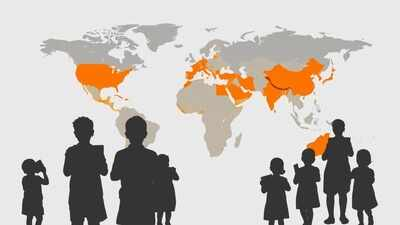Hidden Inequities in Gulf Education have come to light in a major 2025 global study that reviewed access to education, quality of learning, and regional disparities. The findings show that while Gulf countries have made progress in building educational infrastructure, several invisible barriers still prevent equal learning opportunities for many students.
The report, published by the International Education Equity Review (IEER), analyzed school systems in the Gulf Cooperation Council (GCC) states, including Saudi Arabia, the United Arab Emirates, Qatar, Oman, Bahrain, and Kuwait. It compared factors like teacher training, curriculum relevance, technology access, language gaps, and inclusion of marginalized groups.
According to the study, hidden inequities in Gulf education are deeply rooted in socio-economic differences, gender roles, nationality status, and inconsistent education policies between public and private schools. These issues are rarely discussed but have long-term consequences for youth development and future employment.
Key Findings from the 2025 Study
The study outlined several troubling insights:
- Access vs. Quality
While access to education has expanded, especially with free public schooling in most GCC nations, the quality of education varies sharply between rural and urban areas. Students in remote areas often lack qualified teachers, modern learning tools, or updated syllabi. - Public vs. Private Divide
In many Gulf countries, expatriate children often attend private schools due to restrictions on public education access. This has created a dual system where private institutions offer better facilities but charge high fees, deepening inequality. - Nationality and Legal Status
One of the most critical hidden inequities in Gulf education is the gap between citizens and expatriates. Expatriate children, who form a large part of the population in countries like the UAE and Qatar, face limited scholarship opportunities and fewer support programs. - Gender Inequality
Although girls have shown academic excellence in many Gulf countries, cultural and social expectations still limit their access to certain subjects like STEM (Science, Technology, Engineering, Math) or leadership roles in education. - Digital Divide
The 2025 study emphasized that online learning systems introduced after the COVID-19 pandemic continue to favor students from wealthy families. Poorer students lack internet access, personal devices, or digital literacy skills, leading to poor academic performance. - Inclusive Education for Special Needs
Students with learning disabilities or physical challenges are often excluded from mainstream schools or placed in underfunded special education programs. Gulf education systems are still developing comprehensive inclusion policies. - Teacher Training Gaps
One major area of concern is inconsistent teacher qualification standards. Some schools lack subject-specific trained teachers or ongoing professional development, leading to weak classroom outcomes.
These findings make it clear that hidden inequities in Gulf education are widespread, though not always visible to the public.
Reactions Across the Region

The release of the report sparked discussions across education ministries and reform bodies in the Gulf. Several policymakers acknowledged the concerns and said that new frameworks are being designed to address these invisible barriers.
In Saudi Arabia, the Ministry of Education stated that pilot projects in inclusive education and teacher training would be expanded in 2026. In the UAE, education councils pledged to reduce the public-private performance gap by standardizing assessments and digital access.
Meanwhile, some education experts argued that change must go beyond policy documents. There is a need for cultural shifts in how education is perceived moving from exam results to holistic development, critical thinking, and inclusivity.
Root Causes of the Hidden Inequities
The 2025 global study also explored why these inequities have remained hidden for so long:
- Overemphasis on Rankings: Gulf education reforms often focus on global university rankings or standardized test scores, which can overlook ground-level inequality.
- Lack of Independent Evaluation: Most evaluations come from internal government reviews. Independent studies like this global report are rare.
- Cultural Sensitivities: Discussions around gender roles, nationality status, or special needs inclusion are sometimes considered culturally sensitive and avoided in public policy debates.
Because of this, the term hidden inequities in Gulf education describes not only the disparities themselves but also the lack of visibility and conversation around them.
Recommendations to Bridge the Gaps
The study concluded with several recommendations:
- Equity-Focused Budgeting: Direct more funding toward underserved schools and marginalized student groups.
- National Inclusion Policies: Ensure that special needs education and gender equality are part of every school’s core curriculum.
- Unified Teacher Training Programs: Invest in teacher training across both public and private sectors with region-wide standards.
- Technology for All: Provide internet subsidies, free digital devices, and digital skills training for low-income families.
- Transparent Reporting: Encourage the release of data related to student performance and access by nationality, gender, and ability.
Looking Ahead

The 2025 global study has pushed hidden inequities in Gulf education into the spotlight. It presents both a challenge and an opportunity for the region. By tackling these issues head-on, Gulf countries can make their education systems not just larger but smarter and fairer.
Educational success in the 21st century is no longer about infrastructure alone. It’s about giving every child regardless of their background equal access to learning and growth. The Gulf has the resources and vision to make this a reality, but only if leaders take the next steps quickly and boldly.
Final Thoughts
Hidden inequities in Gulf education may have stayed out of sight for years, but they are now impossible to ignore. With the right policies, transparency, and societal support, Gulf nations can build a future where every student has a fair chance to succeed. The time to act is now.
Also Read – Bold Scholarships Aim to Double Women’s Presence in Gulf Education by 2027


